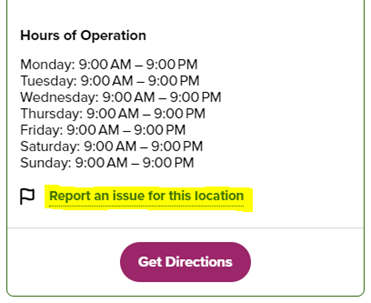Posted on October 30, 2024 by Michelle Hoover -
Collection site names are taken from Google Maps. If the name is wrong, request to change it through the map directly by:
- looking up the location,
- clicking the location,
- clicking the ‘Report an issue for this location’ link, and
- filling out the form by providing the correct name.

Posted on October 30, 2024 by Michelle Hoover -
Collection sites for batteries, electronics, household hazardous waste, lighting, and tires that are reported by producers, or PROs on their behalf, appear on the map.
Collection sites that are considered private (e.g. a recycling bin inside a business that is not accessible to the public) do not appear on the map.
Posted on October 30, 2024 by Michelle Hoover -
A collection site is required to:
- accept all used materials that are designated under the program the collection site operates under*,
- accept materials dropped off free of charge, and
- accept materials dropped off during regular business hours.
The amount and type of materials a collection site must accept varies by which recycling program they operate under.
*More information on what materials must be accepted for each recycling program can be found here.
Posted on March 20, 2024 by Michelle Hoover -
Under Ontario’s circular economy laws, businesses that produce or supply batteries, electronics, household hazardous waste, lighting, and tires are required to provide recycling locations and report them to RPRA. Only locations reported to RPRA appear on the map.
Recycling locations you’re already aware of that don’t appear on the map most likely collect materials not listed above or are operated by a municipality who aren’t required to report recycling locations to RPRA.
Posted on January 31, 2024 by Michelle Hoover -
Blue Box materials (i.e., products and packaging made of metal, glass, paper, flexible plastic, rigid plastic, and beverage containers) are typically collected directly from residences through the provincial Blue Box Program. RPRA’s Where to Recycle map displays public locations for recycling materials that don’t belong in your Blue Box (e.g., batteries, electronics, household hazardous waste, lighting and tires).
For more information on recycling Blue Box materials, visit Circular Materials’ website. Circular Materials is the administrator of Ontario’s Blue Box collection system.
Posted on January 31, 2024 by Michelle Hoover -
No. Recycling drop-off locations displayed on the map cannot:
- charge the public a fee to drop off materials that the location accepts.
- refuse the drop-off of materials displayed on the map. However, recycling locations can request reasonable requirements when consumers drop off an item to ensure health and safety. For example, sites may require that used oil filters are dropped off in sealed containers, light tubes are taped together, etc.
If you are charged a fee or refused drop off, you can report an issue about that specific location to RPRA (see our other FAQ for further instructions).
Posted on January 31, 2024 by Michelle Hoover -
RPRA’s Where to Recycle map displays locations across Ontario where the public can drop off used materials to be recycled, such as batteries, electronics, household hazardous waste (e.g., paint, antifreeze, pesticides), lighting and tires, for free. Materials collected at these locations are reused, refurbished, recycled, or properly disposed of to help keep them out of landfill, recover valuable resources and protect our environment. Learn more here.
Posted on January 31, 2024 by Michelle Hoover -
If you experience an issue when dropping off your recyclables at a location displayed on the map, click the ‘Report an Issue’ link on that specific location. This link will open a form for you to fill out about the issue. RPRA’s Compliance Team will review the issue reported and take action, as necessary.
You may report an issue to RPRA because the recycling location:
- Charges you a fee to drop off materials accepted for recycling.
- *Refuses to accept your materials for recycling (only applicable if your materials are in line with the examples provided on the map).
- Displayed on the map does not actually exist.
- Is not open to the public or does not accept the materials during its business hours.
*Note: Recycling locations can request reasonable requirements when consumers drop off an item to ensure health and safety. For example, sites may require that used oil filters are dropped off in sealed containers, light tubes are taped together, etc.
Posted on January 31, 2024 by Michelle Hoover -
The Where to Recycle map displays locations that the public can drop off used materials to be recycled, such as batteries, electronics, household hazardous waste (e.g., paint, antifreeze, pesticides), lighting and tires, for free. For specific examples of materials accepted and important information to know before dropping off materials, visit the Where to Recycle map.
Posted on January 31, 2024 by Michelle Hoover -
Typically, only municipal depots may require valid IDs when dropping off materials to recycle to confirm you live in that municipality. It is recommended to bring your ID with you to any location, just in case.
Posted on January 31, 2024 by Michelle Hoover -
If the map is not showing any recycling locations near you, you can:
- Try expanding your search by increasing the distance you’re willing to travel or modifying other filters.
- If there still isn’t a recycling location near you, contact the waste management department at your municipality for proper disposal instructions.
Posted on January 31, 2024 by Michelle Hoover -
The recycling locations that appear on the map are reported to RPRA by businesses that run the recycling systems
Posted on January 31, 2024 by Michelle Hoover -
The recycling locations that appear on the map are reported to RPRA by PROs (or producers managing their own collection networks) as the administrators of the collection systems. The public collection activities that PROs report in their registry account are uploaded to the map in near real-time.
